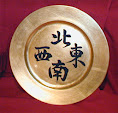Plant-Men are called Wort-Men by the Umathings, and Elves by the Westerners with a further, finer distinction based on colour, as there are several types of Plant-Men. Three of these sub-species (brown, green, and yellow) are called True Elves by the Westerners. Plant-Men obviously do not use these exonyms but refer to themselves with a variety of different endonyms that depend on their plant association (see names in green below).
Plant-men have almost disappeared from Umathela proper, but are quite numerous in the forested lands around it.
Embyli by Dario Corallo
As mentioned above, Plant-Men come in an array of forms and sexes:
Dryads
Dryads are the female Nymphs of the woods, and are far more magical than other Plant-Men. Each Dryad is the protective spirit of a given grove of trees, which she may control under certain circumstances. The role of Dryads in the reproductive cycle of Plant-Men is often of paramount importance.
- Green Elves don't rely on them for reproduction, as they have their own females. When a Green Elf mates with a Dryad, no offspring results.
- Brown elves sometimes rely on them, sometimes not.
- Yellow Elves completely rely on them as they are all males.
Pregnant Dryads give birth to a large seed, not to a living being. The seed is planted, and it grows into a shrub. After two years, the shrub bears a fruit, which contains the child.
Brown Elves [Mreli]
They are associated with deciduous forests, and with trees such as aspen, birch, and oak.
They hibernate in the Dark Season, looking for a hollow tree or a comfortable hole in the ground in which to remain comatose until the Storm Season.
Brown Elves are both male and female, and also interbreed with Dryads, who hold important positions in brown elf society.
Yellow Elves [Embyli]
They are associated with rainforests, jungle evergreens, and palm groves.
They are wholly male and breed with Dryads for procreation.
They are quite aggressive vis-à-vis humans, especially Westerners. In Pamaltela, Embyli are organised in Dryad-ruled queendoms that resist the encroaching human civilisation. These bellicose Yellow Elves are particularly present in the lands to the east of Umathela, where they have fought many deadly wars against the Middle Sea Empire.
Green Elves [Vronkali]
Of the three races of true elves, the Green Elves are the most human-like, having for instance a similar sleeping pattern to the humans', and living in village-like communities with males and females. Vronkali are taller and stronger than any of the other Plant-Man species.
They are associated with coniferous forests, with trees such as fir, pine, and spruce.
Black Elves or Voralans
Hermaphrodite, diminutive squat humanoids with grey skin, and swollen limbs or heads, who inhabit the rare toadstool forests. They are shy, keep to themselves, and avoid combat. However, they can be formidable opponents because of their strange spore-based biological weapons to which they are immune.
Red Elves
Also called called Slorifings by the Umathings, and Goblins by the Westerners. They are small and stunted Plant-Men who inhabit the great swamps to the west and to the south-west of Umathela, thus far from human civilisation. They are associated with ferns and mosses rather than with trees.
Goblins are known to eat humans and to obey a cruel Sorceress Queen. All Slorifings are male, and need diminutive vile-looking Dryads called Olarians to mate.













No comments:
Post a Comment